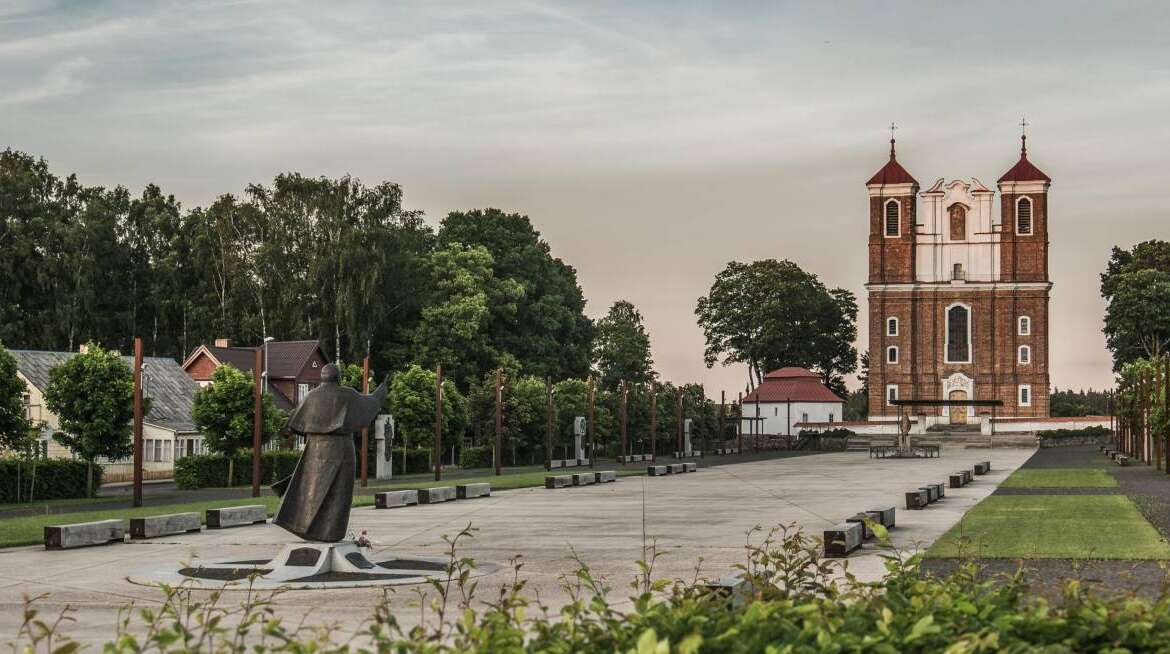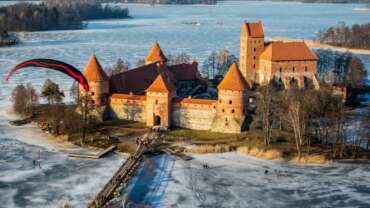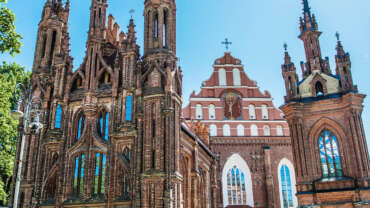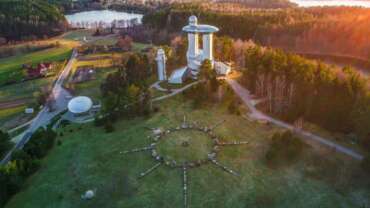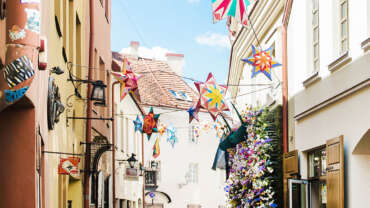Religious Tourism in Lithuania
Even though Lithuania was the last country to embrace Christianity in Europe, there are many sacred Catholic sites to visit all around the country. Šiluva is the site of one of the first apparitions of the Blessed Virgin Mary in Europe. The world-renowned original Image of Divine Mercy, and its history and origins, are waiting to be discovered in Vilnius. There are Baroque monasteries and miraculous paintings of the Blessed Virgin Mary. A journey through Catholic Lithuania will leave you with a lasting impression. And this is not only because of the spectacular architecture – it is also because this journey will take you to the heart of Lithuania’s complex history. You will experience living pilgrimage, which has been a tradition for hundreds of years. And you can find inner spiritual peace in unique locations, each with their own distinct aura and most located in sites of outstanding natural beauty.
Vilnius – the City of Divine Mercy
Pilgrims from around the world travel down the narrow streets of the Old Town of Vilnius and through the leafy paths of nearby Antakalnis to discover the origin of the Image of God‘s Divine Mercy. In 1933, Sister Faustina arrived in Vilnius from Poland to join the order of the Sisters of Divine Mercy in Antakalnis. Over the next several years, she experienced many visions of Jesus, and these became the foundation for the devotion to Divine Mercy. Sister Faustina had experienced visions before, but while living in Vilnius she began to tell her spiritual advisor Fr. Mykolas Sopočka about them. With the help of Fr. Sopočka, descriptions of her visions were relayed to the painter Eugenijus Kazimirovskis from Vilnius, who then painted what became the first Image of Divine Mercy. During the decades of Soviet occupation, the painting appeared destined for historical obscurity. But news of the Image of Divine Mercy and copies of this image gradually spread across the world.
In 2000, Pope John Paul II declared Sister Faustina the first saint of the 3rd millennium. He proclaimed mercy to be the most significant message for the new millennium, and this helped to strengthen devotion to Divine Mercy.
Now, pilgrims can see the authentic Image of Divine Mercy at the Shrine of Divine Mercy located on Dominikonų g. in the Old Town of Vilnius. The shrine is accessible 24 hours a day. Just a short distance away, in the district Antakalnis, is another important location for pilgrims to visit – the House of St. Faustina. Miraculously, the building in which she lived, and where according to her journal she experienced a large number of her visions, is still standing. This is also where she received the Divine Mercy chaplet.
In Vilnius, there are many locations that are connected to the life of St. Faustina and the Blessed Mykolas Sopočka. Pilgrims are invited to visit the most significant sites, which make up the Way of Divine Mercy pilgrimage route. Pilgrims arrive in large number each year for the week of Divine Mercy, which runs from Easter Sunday until the 1st Sunday after Easter, which is known as Divine Mercy Sunday.
Besides the Shrine of Divine Mercy, there are also other sites that proclaim the news of Divine Mercy, as well as received graces. The painting of the Blessed Mother of Mercy is located at the Gate of Dawn Chapel. In the painting, Mary is depicted without the infant Christ and her glance follows every visitor. In mid-November, pilgrims flock to the Feast of the Gate of Dawn.
Šiluva – the site of an apparition of the Blessed Virgin Mary
Ask a Lithuanian what Šiluva is, and they will answer that it is one of the most important spiritual centres in the country. But, it is in fact one of the first sites in Europe where a Marian apparition was seen.
Šiluva is a place where visitors find inner spiritual peace, where you can experience a centuries old pilgrimage tradition and immerse yourself in impressive sacred architecture. The red brick Šiluva Church, built in the 18th century, is probably the last standing monument to Late Baroque sacred architecture. The interior has been preserved for over 200 years, and has hardly been altered. The faithful are drawn to the miraculous painting of the Blessed Virgin Mary with the infant Jesus, and the Chapel of the Apparition. The magnificent 44-meter-high building was designed by architect Antanas Vivulskis, who also designed the Three Crosses on the Hill of Three Crosses in Vilnius. At the centre of the chapel, there is an altar on a rock where the apparition of the Blessed Virgin Mary was seen in 1608.
The Indulgence Feast (also known as the Feast of Šiluva) is a very special celebration that takes place in Šiluva from September 7th-15th. It is the largest event of its kind in Lithuania.
The Hill of Crosses
Desecrated but never destroyed, set on fire but never burned down, the Hill of Crosses is a potent symbol of faith, hope, and freedom. And for pilgrims, it is another must-visit location in Lithuania. The Hill of Crosses near Šiauliai is a hill covered with thousands of wooden crosses. During the Soviet era, these crosses were removed by the authorities, but locals continuously replaced them. In 1993, Pope John Paul II prayed here, and he often mentioned the sacred site in his homilies and speeches. He later sent a crucifix to Lithuania which was placed on the hill, and today pilgrims begin and end their journeys at this location.
While Condé Nast Traveller includes this site as one of the Top 20 scariest places in the world (and perhaps the authors wouldn‘t want to spend a night on the hill), for locals and visitors alike this is a place of hope and enlightenment, reflecting Lithuania’s historical and cultural traditions. One unique annual cultural tradition is the Feast of the Hill of Crosses, which takes place on the last Sunday of July and attracts thousands of pilgrims.
The Basilica in Trakai
Located in a beautiful corner of the Lithuanian countryside, Trakai is the country’s former historical capital, and also served as the seat of Grand Duke Vytautas. The city’s history does not only involve the impressive Trakų Castle, but also the Trakai Basilica of the Visitation of the Blessed Virgin Mary, with its 15th century Gothic and Baroque features. It received the status of Basilica in 2017. This sanctuary remained the spiritual center for the city of Trakai for many centuries – it never closed, and was always used for religious purposes.
Trakai Basilica boasts a miraculous painting of the Mother of God which has been displayed there for 600 years. Currently, 400 milagros (votives) surround the painting – gratitude for miraculous graces which the prayerful have received here for hundreds of years. 300 years ago, this painting was adorned with crowns received from the pope at that time, and is the first painting to be officially crowned in Lithuania. The painting arrived in Trakai as a gift from the Byzantine Emperor on the occasion of the baptism of the ruler Vytautas the Great. As time passed, the painting was repainted by another artist. Yet it still remained revered by residents of Trakai and its surrounding regions, and not only by Catholics, but also by members of local Orthodox and Muslim communities.
Today, many people of faith from Lithuania and other countries visit the Basilica. Pilgrims gather for the annual Feast of the Nativity of Our Lady which takes place on August 15th and September 8th. The pilgrimage is a 30 km journey from the Gate of Dawn in Vilnius to the Basilica in Trakai.
Monasteries
Lithuanian monasteries tell a variety of stories. In some, you will find impressive architectural structures or historic books written by monks. In others, monks and nuns of various orders, clad in their habits, can be seen in their centuries-old cells. They devote their time to prayer, receiving pilgrims, and working with local communities. Visitors can experience these stories and the surrounding wonders of nature where the monks and nuns live to this day.
Monasteries in Kretinga
Not far from the Baltic Sea is the city of Kretinga. It has a population of approximately 18,000, and five functioning monasteries / convents. The city of Kretinga (then called Karolštat), along with a church and monastery, were established by the famous Lithuanian military leader Jonas Karolis Chodkevičius. The elegant architecture of that age can be seen at the Franciscan Monastery, and at the Church of the Annunciation to the Blessed Virgin Mary. This structural ensemble was established in the center of Kretinga. Even though the monastery was closed during Soviet times, the monks returned after Lithuania’s independence, and have continued their missionary work there for the last 30 years.
The other monasteries and convents in Kretinga are exclusively for women. St. Clara’s Monastery is the only one of its kind in the Baltic States. The nuns there live a contemplative life and spend their time in prayer, only leaving the premises if absolutely necessary. The Convent of the Sisters of Mother Teresa helps anybody who has lost their physical and spiritual health. At the Blessed Virgin Mary’s Ceaseless Help of God’s Home of the Franciscan Sisters, the nuns receive those who are seeking spiritual rest. The nuns at the Most Sacred Heart Franciscan Missionary Congregation teach religion and take care of abused children, the sick, and the elderly.
Pažaislis Monastery
Surprising as it may sound, Pažaislis Monastery is quite possibly the most romantic place in Lithuania. A genuine baroque diamond from the 17th century, the monastery was built by the affluent, influential and religious Pacas family. Although the monastery has been devastated multiple times during various wars, artwork by Italian artists Giovanni Battista Frediani, the brothers Pietro and Carlo Puttini, Joano Meri, and Giuseppe Rossi, and the Florentine painter Michelangelo Palloni, all withstood the test of time. The sound of music beneath the arches of the church reveals its beauty as many concerts and music festivals take place here. The silence of the monastery is managed by the order of the Sisters of St. Casimir. In the southern part of the monastery you will find the Sacral Heritage Museum of the Pažaislis Monastery. Next to it is Monte Pacis, a unique dining and hospitality complex where you can experience a contemporary interpretation of historical dishes.
Tytuvėnai Monastery
Tytuvėnai Monastery was designed to be well-proportioned, small, and elegant, and to include a family mausoleum. In the early 17th century, Andrejus Valavičius, the standard-bearer of the Lithuanian Grand Duchy, began construction of the monastery complex. It was built initially in the Gothic spirit, and then intertwined with Renaissance-style details. However, the largest proportion of the monastery is dedicated to Baroque architecture. Today, this Franciscan monastery is in excellent condition, and is a unique architectural monument located deep in the of heart of rural Lithuania. Nevertheless, it has already been discovered by pilgrims from all around the world.
The Pilgrim Centre located here provides a number of activities for curious visitors to try in order to gain an experience of life as a monk. These include by writing with a goose feather, tasting kvass, and assembling a rosary.
Spiritual trips to Lithuania’s undiscovered churches, monasteries and other sacred places
Every time we plan a trip, we look for exciting and unique experiences. We want to visit places few have seen before. And take one-of-a-kind, irreplicable pictures. We also search for a feeling of spiritual fulfilment, seeking to strengthen our soul against stress and uncertainty. How does one find the middle ground while wanting so many different things? The travel experience can be transformed by simply raising our heads, where the church towers soar skyward. And it is the remote churches and monasteries that help us maintain ties with the generations that came before. There, stress and anxiety simply disappear.
It’s possible you might have never thought of taking such a trip, but we have some ideas that might convince you. There are places for spiritual experiences all across Lithuania – from an underwater cross to a church in a tree – that all deserve a detour. Or maybe even an epic road trip covering them all.
THE VIRTUAL PILGRIMAGE ROUTE OF POPE SAINT JOHN PAUL II IN LITHUANIA
1.2 million kilometres. This is the estimated length of all the travels John Paul II, often referred to as the great pilgrim, made as Pope. Lithuania is one of the 129 countries visited during his pontificate. John Paul II first kissed Lithuanian land on September 4, 1993. This was the first-ever visit of the Holy Father to the territory of the former USSR (John Paul II carried on his travels from Lithuania to Latvia and Estonia).
The virtual route created by the National Tourism Development Agency Lithuania Travel includes the Lithuanian houses of worship visited by John Paul II himself together with the country’s most important sacral landmarks listed in the Pilgrimage Route of Pope Saint John Paul II in Lithuania.



